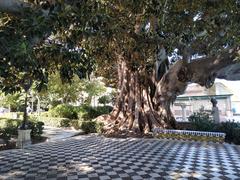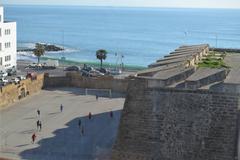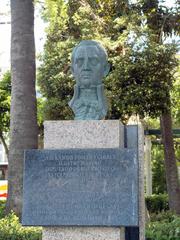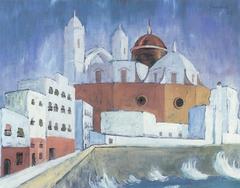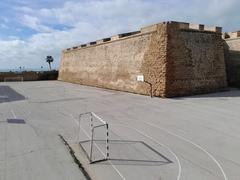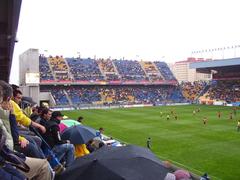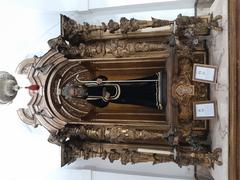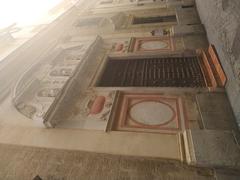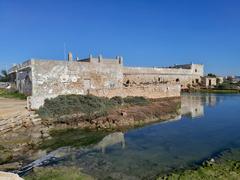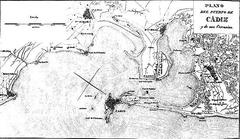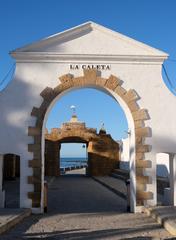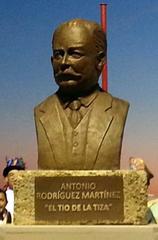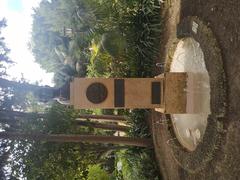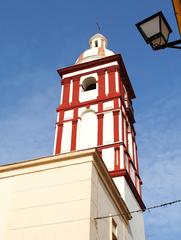Cádiz Visiting Hours, Tickets, and Historical Sites Guide
Date: 04/07/2025
Introduction to Cádiz Historical Sites and Visitor Information
Situated on Spain’s southwestern coast, Cádiz is celebrated as one of Western Europe’s oldest continuously inhabited cities. Founded over 3,000 years ago by Phoenician traders as Gadir, Cádiz’s layered history includes Phoenician, Carthaginian, Roman, Visigothic, Islamic, and Christian influences. Its strategic maritime location fostered an extraordinary cultural and architectural heritage, making the city a vital hub during the Age of Discovery and for trade with the Americas. Today, travelers are drawn to its ancient archaeological sites, such as the Roman Theatre and Phoenician sarcophagi, as well as iconic Baroque and Neoclassical landmarks like the golden-domed Cádiz Cathedral (Wikipedia; Visit Andalucia; Xixerone). Vibrant cultural events—most notably the Carnaval de Cádiz and Semana Santa—offer visitors a unique blend of tradition, music, and local satire (Visiting Cadiz; turispanish.com). This comprehensive guide provides detailed insights into Cádiz’s historical significance, must-see attractions, up-to-date visiting hours, ticketing information, accessibility, and travel tips to ensure a memorable Andalusian experience.
Table of Contents
- Introduction
- Historical Overview: From Phoenician Foundations to Modern Cádiz
- Essential Cádiz Historical Sites and Visitor Information
- Cádiz Visiting Hours, Tickets, and Guided Tours
- Travel Tips and Accessibility
- Cultural Events and Gastronomy
- Frequently Asked Questions (FAQ)
- Conclusion and Planning Resources
- References
Historical Overview: From Phoenician Foundations to Modern Cádiz
Phoenician and Ancient Origins
Cádiz’s origins stretch back over three millennia to its founding by Phoenician traders as Gadir around 1100 BCE (Wikipedia; Visit Andalucia). The city’s strategic location made it a prime center for trade with the Tartessian civilization, and archaeological discoveries such as Phoenician sarcophagi underscore its ancient legacy (Britannica). Myths credit Hercules with its founding, and the Temple of Melqart was one of the ancient Mediterranean’s most important shrines (Visit Andalucia).
Carthaginian, Roman, and Medieval Eras
By the 6th century BCE, Carthaginian influence replaced Phoenician rule, and Gadir played a significant role in the Punic Wars. The Romans captured the city after the Second Punic War, renaming it Gades. Roman Cádiz thrived as a cosmopolitan port—its Roman Theatre, uncovered in 1980, remains a highlight (Xixerone). After a period of decline under the Visigoths, Muslim forces revitalized Cádiz in the 8th century, integrating it into Al-Andalus. The city was later retaken by Alfonso X of Castile during the Christian Reconquista (Wikipedia).
The Age of Discovery and Commercial Zenith
The 15th and 16th centuries marked Cádiz’s ascent as a major port for Spain’s transatlantic expeditions. Notably, Columbus embarked on his second and fourth voyages from Cádiz (Wikipedia). The city became the main port for the Spanish treasure fleet, enduring pirate raids and international conflicts, including Sir Francis Drake’s 1587 attack (Wikipedia). In the 18th century, Cádiz’s commercial prosperity attracted merchants from across Europe, resulting in a cosmopolitan urban fabric (Visit Andalucia).
Modern Cádiz and Living Heritage
Cádiz played a pivotal role during the Peninsular War, serving as the seat of Spain’s first liberal constitution in 1812. While the 19th and 20th centuries brought challenges—from loss of colonial trade to industrial decline—the city has preserved its architectural and cultural richness (Visit Andalucia). Today, Cádiz is celebrated for its festivals, vibrant streets, and enduring maritime traditions.
Essential Cádiz Historical Sites and Visitor Information
Cádiz Old Town (El Pópulo)
The atmospheric Old Town, nearly encircled by ancient walls and the sea, is an open-air museum of Cádiz’s history. Wandering through El Pópulo’s medieval arches and narrow lanes offers an immersive journey through centuries past (Explored by Marta). Guided walking tours (1.5–2 hours, €15–20) reveal hidden gems and operate daily between 10:00 AM and 6:00 PM.
Cádiz Cathedral and Bell Tower
The Catedral de Cádiz is a masterpiece blending Baroque and Neoclassical styles, constructed from 1722 to 1838 (Official Cádiz Tourism). The golden dome and ornate interior reflect the city’s 18th-century prosperity. Visitors can enter the cathedral and crypt from 10:00 AM to 8:00 PM (adults €6, discounts for seniors and EU citizens). The Bell Tower (Torre de Poniente) offers panoramic views and is open from 10:00 AM to 7:00 PM (Explored by Marta).
Torre Tavira
Of Cádiz’s 133 remaining merchant watchtowers, Torre Tavira stands tallest. Open daily from 10:00 AM to 7:00 PM (€8 entry), it features a camera obscura offering live panoramic city views (Official Cádiz Tourism). Guided tours are available in English and Spanish.
Roman Theatre
Dating back to the 1st century BC, the Roman Theatre is among Spain’s oldest and largest. Open Tuesday to Sunday, 10:00 AM to 6:00 PM, with free admission, visitors can explore remains and a small museum (Official Cádiz Tourism). Accessibility is limited due to uneven terrain.
Museum of Cádiz
Located in Plaza de Mina, the Museum of Cádiz features archaeology, fine arts, and ethnography sections. The Phoenician marble sarcophagi are highlights (Official Museum Website). Admission is free for EU citizens (€1.50 for others). Open Tuesday to Saturday, 10:00 AM to 7:00 PM, and Sundays until 3:00 PM.
La Caleta Beach and Seaside Fortresses
La Caleta Beach, flanked by Castillo de Santa Catalina and Castillo de San Sebastián, is renowned for stunning sunsets and historic ambiance (Official Cádiz Tourism). Castillo de Santa Catalina is open Wednesday to Sunday, 11:00 AM to 7:00 PM (€3 entry). Castillo de San Sebastián offers evocative walks along its causeway.
Playa de la Victoria and Santa María del Mar
Playa de la Victoria is Cádiz’s main urban beach, boasting Blue Flag status and a lively promenade (Official Cádiz Tourism). Santa María del Mar, nearby, is the closest expansive beach to the Old Town.
Mercado Central de Cádiz and Plaza de las Flores
The bustling Mercado Central (Monday to Saturday, 8:00 AM to 3:00 PM) is ideal for sampling local seafood and produce (Official Market Website). Plaza de las Flores, adjacent, offers vibrant markets and cafés (Explored by Marta).
Genovés Park
The city’s largest park, open daily 9:00 AM to 9:00 PM, is a botanical oasis with oceanfront views (Official Cádiz Tourism).
Sunset Catamaran Cruises
From April to October, sunset catamaran cruises depart daily from Sancti Petri port (~€25/person), offering spectacular views of the bay (Explored by Marta).
Cádiz Visiting Hours, Tickets, and Guided Tours
Main Sites and Practical Information
- Cádiz Cathedral: 10:00 AM–6:30 PM (last entry 6:00 PM), €6 adults, discounts for students/seniors (Official Cádiz Tourism).
- Roman Theatre: 10:00 AM–7:00 PM (summer), 10:00 AM–5:00 PM (winter), ~€3.50.
- Torre Tavira: 10:00 AM–7:00 PM, €8 adults.
- Museum of Cádiz: Tuesday–Saturday, 10:00 AM–7:00 PM; Sunday, 10:00 AM–3:00 PM. Free for EU citizens.
Tickets can be purchased onsite or online (recommended during peak seasons). Many attractions offer guided tours and combined tickets.
Travel Tips and Accessibility
- Best Time to Visit: Spring (March–May) and early autumn (September–October) offer ideal weather and fewer crowds.
- Getting Around: Cádiz is accessible by train from Andalusian cities. Walking is best for exploring the old town, while buses and taxis serve longer distances.
- Accessibility: Key sites like Cádiz Cathedral and the Museum of Cádiz offer wheelchair access. For other sites, check individual accessibility features in advance.
- Photography: The Torre Tavira, Castillo de San Sebastián, and La Caleta offer superb photo opportunities.
Cultural Events and Gastronomy
Festivals
Cádiz’s cultural calendar is anchored by the exuberant Carnaval de Cádiz (February/March) and solemn Semana Santa processions (Visiting Cadiz; turispanish.com). Year-round events include food festivals, flamenco gatherings, and local saint’s days (hace.es).
Gastronomy
Cádiz’s cuisine reflects its maritime legacy: try pescaito frito (fried fish), tortillitas de camarones (shrimp fritters), and local tuna at the Mercado Central (visitcostablancaspain.com). Tapas bars and beachside chiringuitos offer regional specialties and sherry wines.
Frequently Asked Questions (FAQ)
Q: What are the typical visiting hours for Cádiz’s main attractions?
A: Most open between 10:00 AM and 6:00–7:00 PM; always check official websites for seasonal changes.
Q: Where can I buy tickets for Cádiz’s historical sites?
A: Tickets are available onsite and often online for convenience, especially during busy periods.
Q: Are guided tours available?
A: Yes, many sites offer guided and audio tours in several languages; advance booking is recommended.
Q: Is Cádiz accessible for visitors with mobility challenges?
A: Many main sites are accessible, though some historic areas remain challenging; confirm with individual attractions.
Q: When is the best time to visit Cádiz for festivals?
A: Carnaval (February/March) and Semana Santa (spring) are the most celebrated periods.
Conclusion and Planning Resources
Cádiz offers a unique journey through millennia of history, from its Phoenician roots to its vibrant present. With its diverse historical sites, accessible visiting hours, affordable tickets, and immersive cultural experiences, Cádiz welcomes both history enthusiasts and casual travelers. Plan ahead, book your tickets online, and explore the city’s living heritage and famed gastronomy. For real-time updates, download the Audiala app and follow official Cádiz tourism platforms.
References and Further Reading
- Wikipedia
- Visit Andalucia
- Xixerone
- Visiting Cadiz
- turispanish.com
- Official Cádiz Tourism
- Explored by Marta
- Official Museum Website
- Official Market Website
- hace.es
- visitcostablancaspain.com
